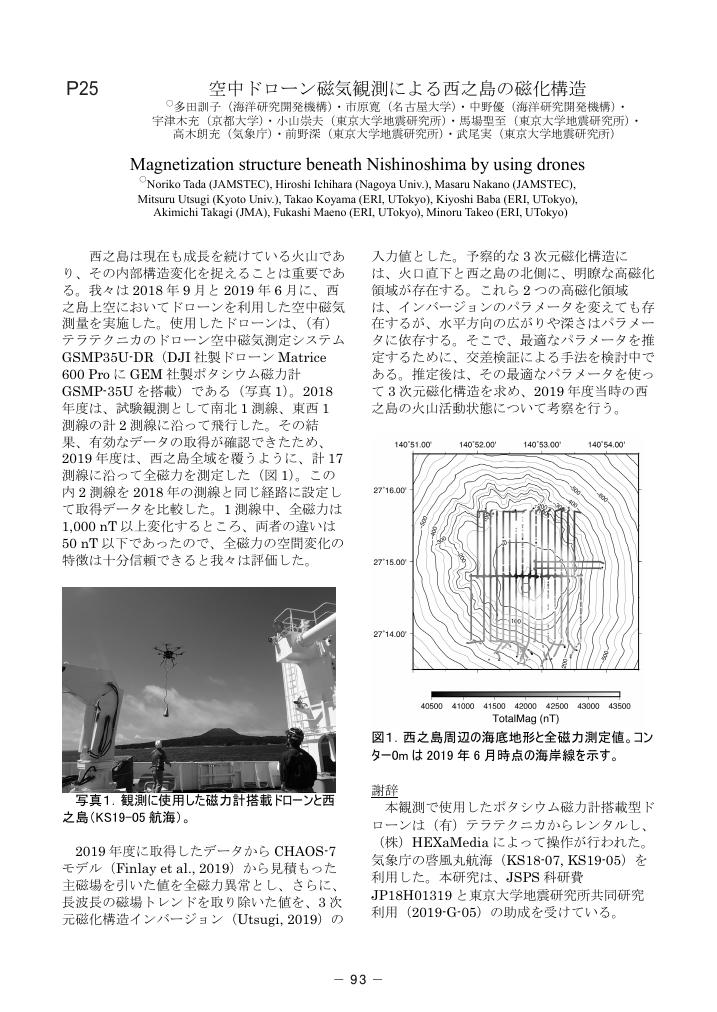- 著者
- 穴井 千里 宮縁 育夫 宇津木 充 吉川 慎 望月 伸竜 渋谷 秀敏 大倉 敬宏
- 出版者
- 特定非営利活動法人 日本火山学会
- 雑誌
- 火山 (ISSN:04534360)
- 巻号頁・発行日
- vol.66, no.3, pp.171-186, 2021-09-30 (Released:2021-10-29)
- 参考文献数
- 29
Nakadake volcano, the current active center of the Aso central cones (Kyushu), is one of the most active volcanoes in Japan. It has been active since ca. 22-21 cal ka, and has formed the old edifice (22-21 cal ka), the young edifice (around 5 cal ka) and the youngest pyroclastic cone (until present). The lava flows from the young edifice spread on the flank of the volcano several times around 5 cal ka. These lavas are supposed to give stratigraphic markers for constructing the eruptive history of Nakadake volcano, but the similarity in chemical composition and lithology hampers distinguishing and correlating them. We have conducted a paleomagnetic study to distinguish and correlate the lavas since the paleomagnetic secular variation (PSV) provides a high-resolution age information. If lava units have a temporal difference of more than 50 years, they could be distinguished by their paleomagnetic directions. The samples were collected from 9 lava flows and 8 agglutinate layers (welded scoria-fall deposits) and were subjected to the paleomagnetic and rock-magnetic measurements. These samples, from visual inspection, appear to be influenced by chemical alteration in the surface of the outcrop by sulfides of volcanic gases. To check a rock-magnetic effect of the chemical alteration of the lavas and agglutinates, thermomagnetic analyses were made on chip samples from the top (surface of rock) and bottom (inside of rock) of the collected paleomagnetic cores. The thermomagnetic analyses indicate that the core top and bottom samples show the same behaviors, in spite of the difference in color, and the carriers of magnetization of each core are titanium rich (titanium content, x, is about 0.6) and poor (x is about 0.1-0.2) titanomagnetites. The natural remanent magnetization of each sample shows a simple, single vector component in alternating field demagnetization experiments, which well defines the primary component. Site mean directions can be categorized into three different direction groups. These data suggest that the eruption producing lava flows and/or agglutinates occurred at three different ages. Furthermore, the paleomagnetic directions of one group is not consistent with the directions of the eruptive ages of Nakadake young edifice assigned from the previous stratigraphic studies. Comparing these directions with the paleomagnetic secular variation curve which has been drawn from basaltic volcanoes in the northwestern part of Aso central cones, the ages of the direction groups can be assigned to around 6.0-4.3 cal ka and 3.5 cal ka, respectively. This result demonstrates that paleomagnetic studies can greatly contribute for establishing the eruptive histories of volcanos.
3 0 0 0 OA 広帯域MT法データから推定される阿蘇火山のマグマ供給系と浅部熱水系
阿蘇火山の地下構造を求める目的で、広帯域MT探査法による比抵抗構造調査をカルデラ内外で実施した。2015年に56測点、2016年に46測点でデータを取得し、それらの結果はHata et al. (2016,1018)で報告している。その後、それまで噴火活動により近接できなかった中岳第一火口周辺にて、2017年から2018年にかけて9測点で観測を行った。前回の報告では、中岳下から深度15km程度まで延びる円柱状の低比抵抗体が求められている。比抵抗値はもっとも低いところで1 Ω・m以下になり極めて低い。その一部は地震波トモグラフィーによって求められている低速度異常域(Sudo and kong 2001)と重なっている。また、深度15km以深のシル状地殻変動源(国土地理院、2004)や深部低周波地震(気象庁)に向かって延びているように見える。このことから、この低比抵抗体は深部のマグマ溜まりから中岳へ延びるマグマ供給系であると解釈されている。前回の解析では、深度2kmぐらいから浅部の構造が不明瞭であった。そこで、有史以来、頻繁に噴火活動を繰り返している中岳第一火口と低比抵抗体の関係を明らかにするべく、2015年のデータに第一火口周辺の9観測点を加え、あらためて3次元の比抵抗構造解析を行った。その際に、鉛直方向のグリッド形状を変更したため、地形を与え直した。インバージョンでは測定周期0.005から2380秒のうち、16周期を選択し、リモートリファレンス処理を行った4成分のMTインピーダンステンソルと2成分のティッパーベクトルを用いた。まず、インピーダンスとティッパーのエラーフロアをそれぞれ20、30%とし、RMS値の低い結果を初期値として、次にエラーフロアをそれぞれ5、10%としたイタレーションを10回行い、最もRMS値の低いものを最終結果とした。得られた結果をみると、低比抵抗体の最上部は中岳第一火口直下に位置している。また、その深度は海水準付近となり、2014年の噴出物のメルトインクルージョンの分析から推定されたマグマの深度の上限が海水準付近であること(Saito et al.,2018)と良い一致を示す。このことから、低比抵抗体は第一火口にマグマを供給する火道であると推測される。ただし、低比抵抗体の水平方向の幅は1km程とかなり厚く、火道の周囲に塩分濃度の濃い流体が存在しているのかもしれない。一方、第一火口から山腹にかけて、海水準から深度1km程度で数Ω・mの低比抵抗域が水平方向に広がっている。垂玉温泉付近の坑井のデータや、山麓での湧水の化学成分等を参考にすると、火道を中心として山体内に発達した熱水系を表しているようである。
1 0 0 0 OA 2016年熊本地震と関連する活動に関する総合調査
- 著者
- 清水 洋 松本 聡 酒井 慎一 岡田 知己 渡辺 俊樹 飯尾 能久 相澤 広記 松島 健 高橋 浩晃 中尾 茂 鈴木 康弘 後藤 秀昭 大倉 敬宏 山本 希 中道 治久 山中 浩明 神野 達夫 三宅 弘恵 纐纈 一起 浅野 公之 松島 信一 福岡 浩 若井 明彦 大井 昌弘 田村 圭子 木村 玲欧 井ノ口 宗成 前原 喜彦 赤星 朋比古 宇津木 充 上嶋 誠 王 功輝 ハザリカ ヘマンタ 矢田 俊文 高橋 和雄
- 出版者
- 九州大学
- 雑誌
- 特別研究促進費
- 巻号頁・発行日
- 2016-04-22
2016年熊本地震について、地震活動や地殻変動、活断層、火山活動への影響、地震災害の特徴などを調査した。その結果、熊本地震は布田川・日奈久断層帯の右横ずれ運動によって発生したが、複数の断層面と複雑な断層形状を持つことを明らかにした。また、建物被害や土砂災害の地盤との関係、特に、地盤の過剰間隙水圧が地すべりの発生要因であることを明らかにした。さらに、災害情報や災害過程、被災救援、エコノミークラス症候群などについての調査から、広域複合災害の問題点と対応策を提示した。
1 0 0 0 OA 空中ドローン磁気観測による西之島の磁化構造
- 著者
- 多田 訓子 市原 寛 中野 優 宇津木 充 小山 崇夫 馬場 聖至 高木 朗充 前野 深 武尾 実
- 出版者
- 特定非営利活動法人 日本火山学会
- 雑誌
- 日本火山学会講演予稿集 2020 (ISSN:24335320)
- 巻号頁・発行日
- pp.93, 2020 (Released:2021-02-01)
